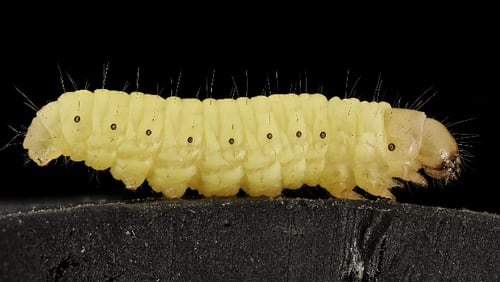Of the 300 million tons of plastic produced globally each year, only 10 percent is recycled, according to the World Watch Institute.
A chunk of the rest ends up polluting landfills and oceans, ultimately blighting communities and damaging marine ecosystems.
» RELATED: Trump’s EPA could derail tougher pollution rule at Georgia Power plant
But scientists say a common insect — the wax worm — could be the answer to this global pollution crisis.
In their new research published in the science journal, Current Biology, a team of European scientists reveal the larva of the wax moth can easily chew through the common plastic, polyethylene.
Furthermore, they found the worms can chew big holes in a plastic shopping bag within 40 minutes.
That's big news, considering a trillion plastic bags are used each year − that's nearly 2 million per minute, according to the Earth Policy Institute.
» RELATED: Georgia House votes down bill to bar local bans on plastic bags
The findings were actually discovered by accident — the scientists noticed plastic bags containing the wax worms became permeated with holes.
After 12 hours, the bag was significantly shredded and scientists found the worms had left behind ethylene glycol, a sign they really did break the plastic down.
Though the insects don’t normally eat plastic, wax moths lay their eggs in beehives and the worms hatch and live on beeswax, which is described by lead researcher Federica Bertocchini as “a sort of natural plastic.”
The scientists believe it’s possible the digestion of beeswax and polyethylene could involve similar types of chemical bonds.
» RELATED: Scientists discover rare, alienlike giant shipworm in Philippines
“We are planning to implement this finding into a viable way to get rid of plastic waste, working towards a solution to save our oceans, rivers, and all the environment from the unavoidable consequences of plastic accumulation,” Bertocchini said. “However, we should not feel justified to dump polyethylene deliberately in our environment just because we now know how to bio-degrade it.”
This isn’t the first research about wax worms and polyethylene.
In 2014, another team of scientists found bacteria in wax worms’ digestive systems could start degrading polyethylene after two months — not nearly as quickly as Bertocchini’s sample.
But Woods Hole Oceanographic marine biologist Tracy Miner told National Geographic the focal point should still be on recycling more and producing less plastic.
“Polyethylene is a high-quality resin that can be upcycled in many ways and can fetch up to $500 per (ton),” he said in an email. “In my opinion, although this is an amazing natural history story and wonderful academic exercise, it is not a solution for disposing of polyethylene as this is throwing away money.”
Read the full study in the Current Biology journal.







